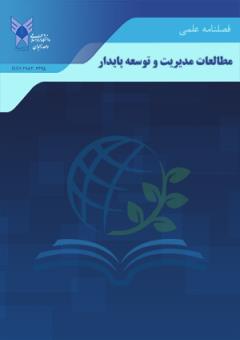الگوی مدیریت منابع انسانی استراتژیک با تأکید بر تکنیکهای حسابداری مدیریت در سازمان بنادر و دریانوردی کشور
محورهای موضوعی : مدیریت منابع انسانی
مهدی اسماعیلی
1
![]() ,
رضا ستوده
2
,
رضا ستوده
2
![]() ,
حبیب پیری
3
,
حبیب پیری
3
![]() ,
عباسعلی حق پرست
4
,
عباسعلی حق پرست
4
![]()
1 - دانشجوی دکتری، گروه حسابداری، واحد زاهدان، دانشگاه آزاد اسلامی، زاهدان، ایران
2 - استادیار گروه مالی و حسابداری، دانشکده علوم انسانی، دانشگاه میبد، میبد، ایران.
3 - استادیار گروه حسابداری، واحد زاهدان، دانشگاه آزاد اسلامی، زاهدان، ایران.
4 - استادیار گروه حسابداری، واحد زاهدان، دانشگاه آزاد اسلامی، زاهدان، ایران.
کلید واژه:
چکیده مقاله :
هدف اصلی پژوهش حاضر تبیین الگوی مدیریت منابع انسانی استراتژیک با تأکید بر تکنیکهای حسابداری مدیریت در سازمان بنادر و دریانوردی کشور است. روش پژوهش به صورت آمیخته میباشد و در سال 1403 صورت گرفته است. در بخش کیفی به روش نظریه داده بنیاد با 25 نفر از خبرگان تا اشباع نظری مصاحبه انجام شد. در بخش کمّی جهت رتبه بندی ابعاد و مؤلفههای الگو از آزمون فریدمن استفاده گردید. همچنین، جهت اعتبار سنجی الگو از طریق توزیع پرسشنامه محقق ساخته بین 278 نفر از حسابداران مدیریت، مدیران مالی، حسابداران و اعضای هیأت علمی دانشگاه با استفاده از نرم افزار اسپیاساس صورت گرفت. ابعاد، مؤلفهها و شاخصهای الگوی مدیریت منابع انسانی استراتژیک با تأکید بر تکنیکهای حسابداری مدیریت در قالب 3 بُعد، 12 مؤلفه و 51 شاخص تدوین گردید. با توجه به نتایج پژوهش، ابعاد الگوی مدیریت منابع انسانی استراتژیک عبارتاند از: بُعد استراتژیهای آموزش و توسعه، بُعد استراتژیهای ارزیابی عملکرد و بُعد استراتژیهای مدیریت تغییر و نوآوری. مؤلفههای بُعد استراتژیهای آموزش و توسعه عبارتاند از: مؤلفه حسابداری منابع انسانی، مؤلفه مدیریت کیفیت جامع، مؤلفه تئوری محدودیت و مؤلفه هزینهیابی کیفیت. مؤلفههای بُعد استراتژیهای ارزیابی عملکرد عبارتاند از: مؤلفه کارت ارزیابی متوازن، مؤلفه زنجیره ارزش، مؤلفه حسابداری سنجش مسئولیت، مؤلفه حسابداری زیستمحیطی و مؤلفه بودجهبندی سرمایهای. مؤلفههای بُعد استراتژیهای مدیریت تغییر و نوآوری در الگوی مدیریت منابع انسانی استراتژیک با تأکید بر تکنیکهای حسابداری مدیریت در سازمان بنادر و دریانوردی کشور عبارتاند از: مؤلفه تحلیل سوآت، مؤلفه کایزن، و مؤلفه حسابداری ناب.
The main goal of the current research is to explain the model of strategic human resources management with an emphasis on management accounting techniques in the country's ports and maritime organizations. The research method is mixed and it was carried out in 1403. In the qualitative section, interviews were conducted with 25 experts using the foundation's data theory method until theoretical saturation. In the quantitative part, Friedman's test was used to rank the dimensions and components of the model. Also, a researcher-made questionnaire was distributed among 278 management accountants, financial managers, accountants, and university faculty members using SPSS software to validate the model. The dimensions, components, and indicators of the strategic human resources management model were compiled with emphasis on management accounting techniques in the form of 3 dimensions, 12 components, and 51 indicators. According to the research results, the dimensions of the strategic human resource management model are: the dimension of training and development strategies, the dimension of performance evaluation strategies, and the dimension of change and innovation management strategies. The components of the training and development strategies dimension are: the human resource accounting component, comprehensive quality management component, theory of constraint component, and quality costing component. The components of the performance evaluation strategies dimension are: balanced evaluation card component, value chain component, responsibility accounting component, environmental accounting component, and capital budgeting component. The components of change and innovation management strategies in the strategic human resource management model with emphasis on management accounting techniques in the Ports and Maritime Organization of the country are: the SWAT analysis component, Kaizen component, and the lean accounting component.


